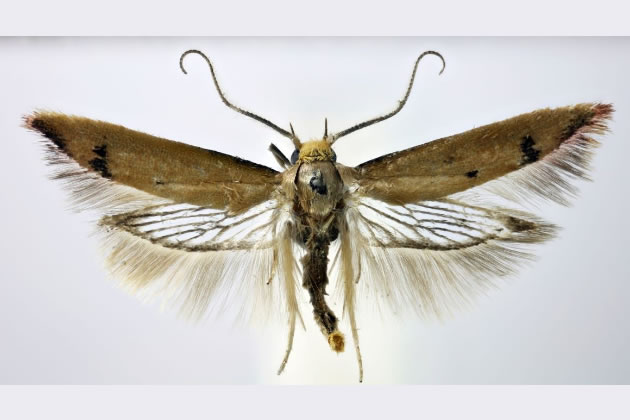Moth Collector Finds New Species in Walpole Park
Barbara Mulligan has insect she identified named after her

Barbara shows off her find. Picture: Natural History Museum
|
December 6, 2023
An amateur moth collector has successfully identified a new species after coming across it in Walpole Park.
Barbara Mulligan was unable to classify the tiny brown insect with a wing length of just 8mm that she caught in her moth trap. After the local moth collector was also unable to identify it, she sought help from other experts in the field including Mark Sterling, a Scientific Associate at the Natural History Museum, who went on to perform a detailed analysis including both morphology and DNA to describe the species’ anatomy.
Tiny samples of the insect provided researchers with a DNA barcode that allowed them to compare the unknown specimen to a huge database containing the barcodes of known moth species from around the world.
Though it didn’t confirm the identity of the Ealing moth, the DNA barcode told the scientists that it belonged to a group of species that includes the Tachystola hemisema. This moth is found in New South Wales, Australia, and itself has become an invasive species in California, and probably also New Zealand and Hawaii.
A specimen of the same type has been sitting undescribed in the Natural History Museum’s collections since 1886. In a bizarre coincidence , the area in Australia where this specimen was found is called Walpole.
‘What Barbara had found was an undescribed species’, said Mark, ‘she found this extraordinary moth which has somehow come over from Western Australia and established itself in three or four places in West London.’
‘And she is still the only person in the UK to have found it. This is a real coup for citizen science.’
 Tachystola mulliganae is originally from Australia
Tachystola mulliganae is originally from Australia
The puzzle was solved by the use of state-of-the-art genetic technique known as ‘genome skimming’ by the Natural History Museum, which allows for a specimen’s genome to be sequenced in tiny little fragments.
‘I took a leg of the Meyrick type specimen for Tachystola hemisema from Sydney, and a leg from one of Meyrick’s specimens from Western Australia’, explains Dr David Lees, the Senior Curator for Microlepidoptera at the Natural History Museum.
‘Both of them produced sequences and by adapting existing data analytics programs we were able to read all the data.’
From sequencing the 135-year-old specimens, a conclusion was made that the two moths were genetically distinct and the Ealing moth matched with the undescribed specimen from Western Australia.
Though the working theory is that the moth travelled to the UK via imported plants, the research team is searching for larvae to confirm how the travelling newcomer wound up in London.
The new species has been named Tachystola mulliganae after Barbara Mulligan as she the only person in the UK to have found the new species around her local area.
The retired housing officer has been catching and breeding moths since she was ten years old and described the outcome as a "a lovely surprise".
Like Reading Articles Like This? Help Us Produce More This site remains committed to providing local community news and public interest journalism. Articles such as the one above are integral to what we do. We aim to feature as much as possible on local societies, charities based in the area, fundraising efforts by residents, community-based initiatives and even helping people find missing pets. We’ve always done that and won’t be changing, in fact we’d like to do more. However, the readership that these stories generates is often below that needed to cover the cost of producing them. Our financial resources are limited and the local media environment is intensely competitive so there is a constraint on what we can do. We are therefore asking our readers to consider offering financial support to these efforts. Any money given will help support community and public interest news and the expansion of our coverage in this area. A suggested monthly payment is £8 but we would be grateful for any amount for instance if you think this site offers the equivalent value of a subscription to a daily printed newspaper you may wish to consider £20 per month. If neither of these amounts is suitable for you then contact info@neighbournet.com and we can set up an alternative. All payments are made through a secure web site. One-off donations are also appreciated. Choose The Amount You Wish To Contribute. If you do support us in this way we’d be interested to hear what kind of articles you would like to see more of on the site – send your suggestions to the editor. For businesses we offer the chance to be a corporate sponsor of community content on the site. For £30 plus VAT per month you will be the designated sponsor of at least one article a month with your logo appearing if supplied. If there is a specific community group or initiative you’d like to support we can make sure your sponsorship is featured on related content for a one off payment of £50 plus VAT. All payments are made through a secure web site. |